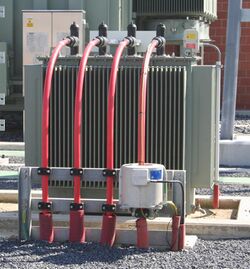Engineering:Grounding transformer

A grounding transformer or earthing transformer is a type of auxiliary transformer used in three-phase electric power systems to provide a ground path to either an ungrounded wye or a delta-connected system.[1][2] Grounding transformers are part of an earthing system of the network. They let three-phase (delta connected) systems accommodate phase-to-neutral loads by providing a return path for current to a neutral.
Grounding transformers are typically used to:
- Provide a relatively low-impedance path to ground, thereby maintaining the system neutral at or near ground potential.[3]
- Limit the magnitude of transient over voltages when restriking ground faults occur.
- Provide a source of ground fault current during line-to-ground faults.
- Permit the connection of phase-to-neutral loads when desired.[2]

Grounding transformers most commonly incorporate a single winding transformer with a zigzag winding configuration, but may also be created with a (rare case) delta-wye transformer.[2][4] Neutral grounding transformers are very common on generators in power plants and wind farms.[2] Neutral grounding transformers are sometimes applied on high-voltage (sub-transmission) systems, such as at 33 kV, where the circuit would otherwise not have a ground; for example, if a system is fed by a delta-connected transformer. The grounding point of the transformer may be connected through a resistor or arc suppression coil to limit the fault current on the system in the event of a line-to-ground fault. [5]
References
- ↑ "Grounding Transformer". http://www.swedishneutral.se/download/Swedish%20Neutral%20Grounding%20Transformer%20Technical%20Specification%20English.pdf.
- ↑ 2.0 2.1 2.2 2.3 Dickinson, Mike (August 19, 2011). "Grounding Transformers". http://www.ecmweb.com/bonding-amp-grounding/grounding-transformers.
- ↑ "Floating Neutral Transformer". 14 August 2021. https://pact.in/blog/2021/08/what-is-a-floating-neutral.
- ↑ "Grounding Transformer FAQs". November 8, 2013. https://www.pacificcresttrans.com/grounding-transformer-faqs/.
- ↑ Martin Heathcote (ed.), J & P Transformer Book, Newnes, 2011 Script error: No such module "CS1 identifiers".pp. 421-422
 |

